
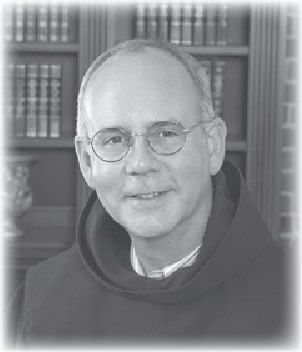 Residing at the Friary, Br. John Summers, O.F.M. offered to write a column for the website which resulted in Friar Factor. Devoted to things Franciscan from a friar's point of view, this series offers an opportunity to go a bit deeper into Franciscan history and life. Residing at the Friary, Br. John Summers, O.F.M. offered to write a column for the website which resulted in Friar Factor. Devoted to things Franciscan from a friar's point of view, this series offers an opportunity to go a bit deeper into Franciscan history and life.

Origins of the Franciscan Religious Habit
The origins of the Franciscan religious habit go back to a wealthy cloth merchant's son who came to be known as Saint Francis of Assisi. In his day, there were only two social classes, the majores (nobility), and the minores (peasants), with a growing group of merchants in a middle state not yet clearly defined.
As he grew in his devotion to our God who became poor to dwell among us, Francis wanted to follow Christ in a very concrete way. Francis decided that, in order to do this to the fullest, he must live a poor life himself, so he adopted the common dress of peasants, a simple tunic of unbleached, un-dyed wool. Many peasants also wore a hood, and a rope around the waist was handy for keeping loose clothing out of the way while working.
When other men asked to join him in his way of life, Francis had them wear peasant clothes, too, and he called them fratrum minorum (lesser brothers). When the church formally recognized and approved the group, the name Ordo Fratrum Minorum, or Order of Friars Minor, became official—"OFM" for short.
Model for the Religious Habit of the Franciscan Friars
In the time of Saint Francis of Assisi, peasant clothing, the model for the religious habit of the Franciscan friars, was a simple tunic of unbleached, un-dyed wool. Many also wore a hood. A rope around the waist was handy for keeping loose clothing out of the way while working.
A medieval peasant would want to avoid cutting a good rope to make it fit—once cut, you could never make it longer again. If their rope was too long, you could just put a knot or two in it so that it didn't drag on the ground. Naturally, waistlines varied in those days, just as now—some needed more rope than others, and some needed more knots.
I suppose that somewhere along the line a friar with three knots in his cord thought, "Hmmm ...three knots ...reminds me of our three religious vows ... poverty, chastity, obedience ...." Thus a practical thing took on a spiritual meaning. But the number of knots wasn't standardized right away. There was a time when some friars put five knots in the cord, reminding them of the wounds in the crucified Christ's hands, feet and side.
Color of the Franciscan Religious Habit
Habit of St. Francis
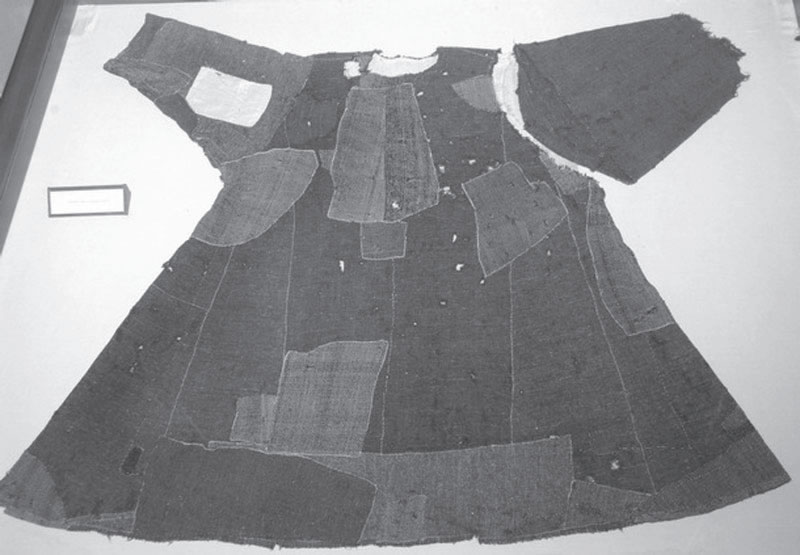 The color of the Franciscan religious habit wasn't always standardized. It was regulated in the late nineteenth century. Originally having been made of unbleached, un-dyed wool, a range of tones would be possible. Sun could cause changes in the color of the cloth. And so could soil, particularly given the hygiene standards of the Middle Ages—something I'd rather not dwell on! The color of the Franciscan religious habit wasn't always standardized. It was regulated in the late nineteenth century. Originally having been made of unbleached, un-dyed wool, a range of tones would be possible. Sun could cause changes in the color of the cloth. And so could soil, particularly given the hygiene standards of the Middle Ages—something I'd rather not dwell on!
Over time, the friars in various places started making habits of brown, gray, blue and other colors. Each region or branch of the Franciscans had its own standard. When Pope Leo XIII united the many groups of Franciscan friars into three branches in 1897, he also dictated that the habit should be brown.
The particular hue of brown can vary these days, from nearly-black to coffee to light milk-chocolate, depending on regional preferences, the yarn (wool, cotton, synthetic or blend), and the particular dye lot of the cloth manufacturer.
An old custom of providing white habits to missionaries, so many of whom were going from cooler northern to warmer southern climates, is still observed by some Franciscans today.
Franciscan Religious Habit
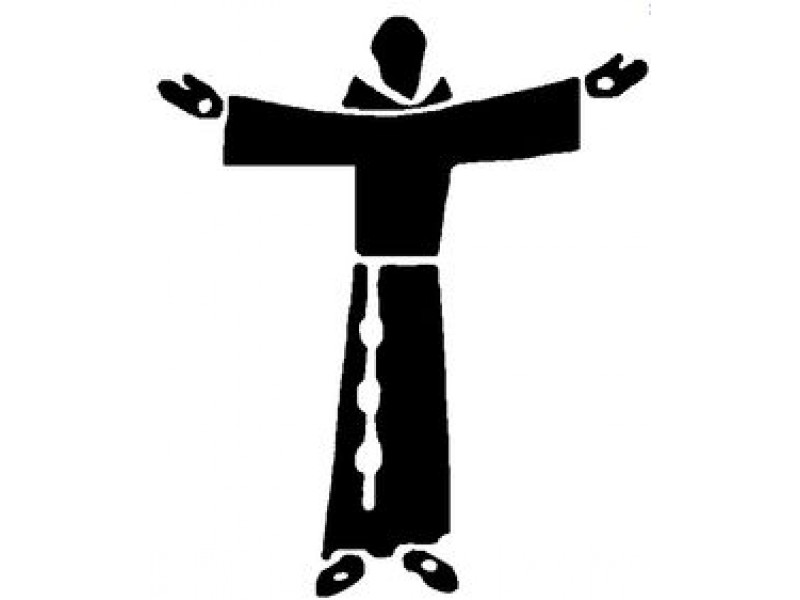 You probably know that there are many forms of crosses—Jerusalem, Celtic, etc. A cross in the shape of the Greek letter "Tau" (like our English capital letter T) is a simple form of cross. Saint Francis of Assisi used to draw the Tau cross along with, or instead of, his signature, and it's now sometimes called the "Franciscan cross." You probably know that there are many forms of crosses—Jerusalem, Celtic, etc. A cross in the shape of the Greek letter "Tau" (like our English capital letter T) is a simple form of cross. Saint Francis of Assisi used to draw the Tau cross along with, or instead of, his signature, and it's now sometimes called the "Franciscan cross."
In the modern Franciscan religious habit, the tunic is cut in the shape of the Tau. Most habits have some pockets concealed in the sleeves or under the hood, and some have vents on the sides in order to reach the pockets of trousers, which most friars wear under the habit these days. In English, the friars call the hood a capuche (pronounced "kah-POOSH," from the French). It's a separate part of the habit, except for one branch of Franciscans that has it sewn permanently in the tunic; a friar of that branch is called Capuchin in English, or Cappuccino in Italian—literally, "hooded one."
And yes, the Franciscan habit's color is the inspiration for the name of the popular coffee drink.
Origins of the Nativity Scene
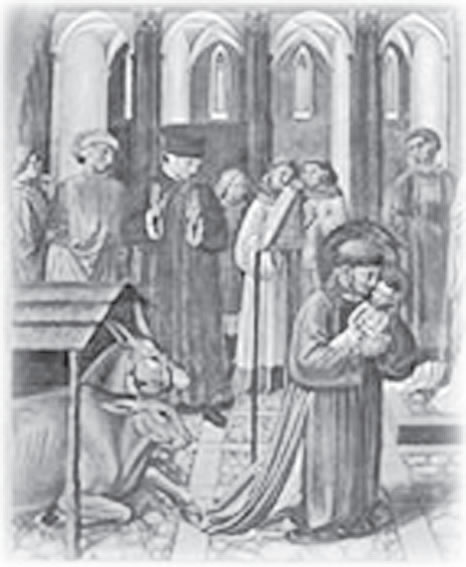 Many credit Saint Francis with popularizing the custom of setting up a nativity scene for Christmas. According to friar Thomas of Celano, Saint Francis's first biographer, one Christmas Eve, on the outskirts of the town of Greccio, Francis instructed people to prepare for Mass by setting up a life-size manger with real hay, live cattle and a carved figure of the infant Jesus. Many credit Saint Francis with popularizing the custom of setting up a nativity scene for Christmas. According to friar Thomas of Celano, Saint Francis's first biographer, one Christmas Eve, on the outskirts of the town of Greccio, Francis instructed people to prepare for Mass by setting up a life-size manger with real hay, live cattle and a carved figure of the infant Jesus.
That Christmas night, Brother Thomas says, while Francis was preaching, something special happened: one villager saw "... a little child lying lifeless in the manger, and he saw the holy man of God [Francis, that is] approach the child and waken him from a deep sleep." This experience was compared to what many felt whenever they heard Francis preach the good news of God's love — the presence of Christ awakened, a presence that, for some people, had been sleeping. And this presence was right in their hearts, not in a far-away place or time.
The Greccio story expresses Saint Francis's insight that God is indeed with us, as near as our own hearts and the hearts of others. It reminds us that we can meet Christ anew wherever we are, in churches and throughout the whole world, at Christmas and all through our lives.
Not all Priests are Friars. Not all Friars are Priests
(pictured: Seán Patrick Cardinal O’Malley, O.F.M. Cap.; Friar, Priest, and Cardinal)
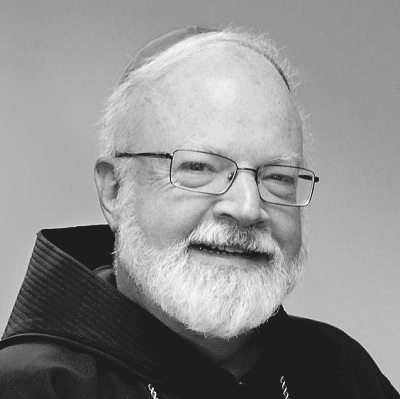 Not all priests are friars. Not all friar's are priests. Confused? You're not alone. Not all priests are friars. Not all friar's are priests. Confused? You're not alone.
In the Catholic Church, presiding at the sacraments is distinctively reserved to ordained people — bishops, priests and deacons. Those not ordained (that is, most of us) are lay people. Lay and ordained — seems simple enough, right?
But there's more. There's a category commonly called "Religious" with a capital "R." It refers to members of religious orders — monks, nuns, friars, sisters, brothers. (For finer distinctions, Google "consecrated life.")
Here's where it can get confusing: Most priests do not belong to any religious order; they're called "diocesan" priests. And some Religious men are ordained, but not all.
The word "friar" is derived from the French for "brother," which is what St. Francis called the men he inspired to form a new order. All Franciscan friars are Religious. They all make the same vows and wear the same brown Franciscan habit. And some are ordained. In common usage in the U.S. today, "friar" usually refers to any member of the order, "Brother" to a lay friar, and "Father" to a friar who is an ordained priest.
Still confused? Just go back to those first two sentences.
Franciscan Lay Brothers and Ordained Priests
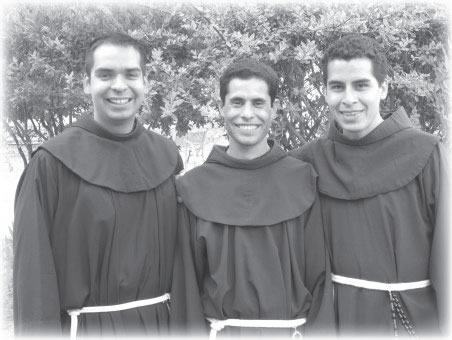 The Franciscan friars have always included both lay brothers and ordained priests. The Franciscan friars have always included both lay brothers and ordained priests.
Most of the first friars were laymen wanting to form a new kind of community based on Gospel values as understood particularly by St. Francis. They wanted to evangelize through the witness of their own lives, living as poor men without property among their neighbors. They weren't seeking any official church ministry. Almost any kind of work was acceptable.
But from the beginning, there were some ordained priests among the friars, too. And within just a few years, many more priests joined. They saw the order as an attractive alternative both to the church's institutional corruption and to the seclusion of life in a monastery. Ordained friars could remain in active ministry while pursuing a more radical form of Christian life.
As the Franciscans grew in popularity, Popes realized that friars could serve the institutional church's efforts at reform. Around 1220, the church started issuing regulations favoring the ordination of friars.
Today, only about 17% of the nearly 15,000 members of the Order of Friars Minor worldwide are lay friars; in the U.S., about 22% and in this western province, about 27%.
Lay Brother or Priest
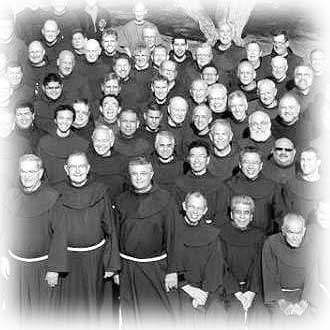 Many friars remember when it was common for men to enter the Franciscan order right after high school. Young friars knew early on which path they would take — to live their Franciscan lives as lay brothers or as priests. The beginning stage of "formation" (preparation for Franciscan life) was in common for lay brothers and those to be ordained. But their experiences diverged quickly. Lay brothers learned trades. Seminarians hit the books. Many friars remember when it was common for men to enter the Franciscan order right after high school. Young friars knew early on which path they would take — to live their Franciscan lives as lay brothers or as priests. The beginning stage of "formation" (preparation for Franciscan life) was in common for lay brothers and those to be ordained. But their experiences diverged quickly. Lay brothers learned trades. Seminarians hit the books.
There was a time when even names made the distinction clear. In those days, new friars received new names, a symbol of starting a new way of life. The practice was for no more than one lay friar and one ordained friar in the province to have the same name at the same time — no more than one "Father Quirinus" and one "Brother Quirinus" ...poor fellows!
These days, men enter the order later. They share most experiences of formation and life in general, and it takes a while for some to decide about ordination. In my case, I completed seminary — a Master of Divinity degree — before realizing that priesthood was not my calling. I'm glad I got the education ...and could keep my name.
Franciscan Friars Ministries
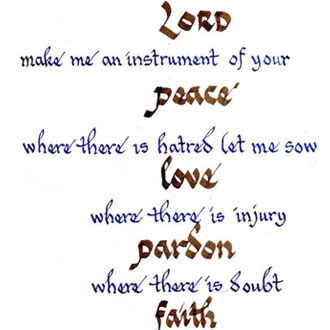 In the Franciscan Province of St. Barbara (a region including Washington, Oregon, California, Utah, Nevada, Arizona and New Mexico) there are about 200 friars. They vary in age, culture, language and experience. In the Franciscan Province of St. Barbara (a region including Washington, Oregon, California, Utah, Nevada, Arizona and New Mexico) there are about 200 friars. They vary in age, culture, language and experience.
Friars teach in schools and universities, practice skilled trades and professions, guide others in private and public prayer, feed the hungry and shelter the homeless, reach out to serve people of other lands and languages, and reach in to care for those confined to hospitals and prisons.
The province cares for 24 urban, suburban, rural and Native American parishes. Other province ministries form 20 individually incorporated institutions, including four retreat centers, three of the original California missions, two service agencies for the poor, and a graduate school of theology. And some institutions have multiple ministries — an old mission can be a parish, historical site, retreat facility and social outreach center.
Some friars work in specialized ministries outside of Franciscan and church institutions. Some work beyond province boundaries — in Mexico, Peru, England, Kazakhstan, Russia and Israel. And some have served in leadership for the Franciscan order worldwide.
Since their founding 800 years ago, the Franciscans and their ministries have been as diverse as the people and places they serve. |



